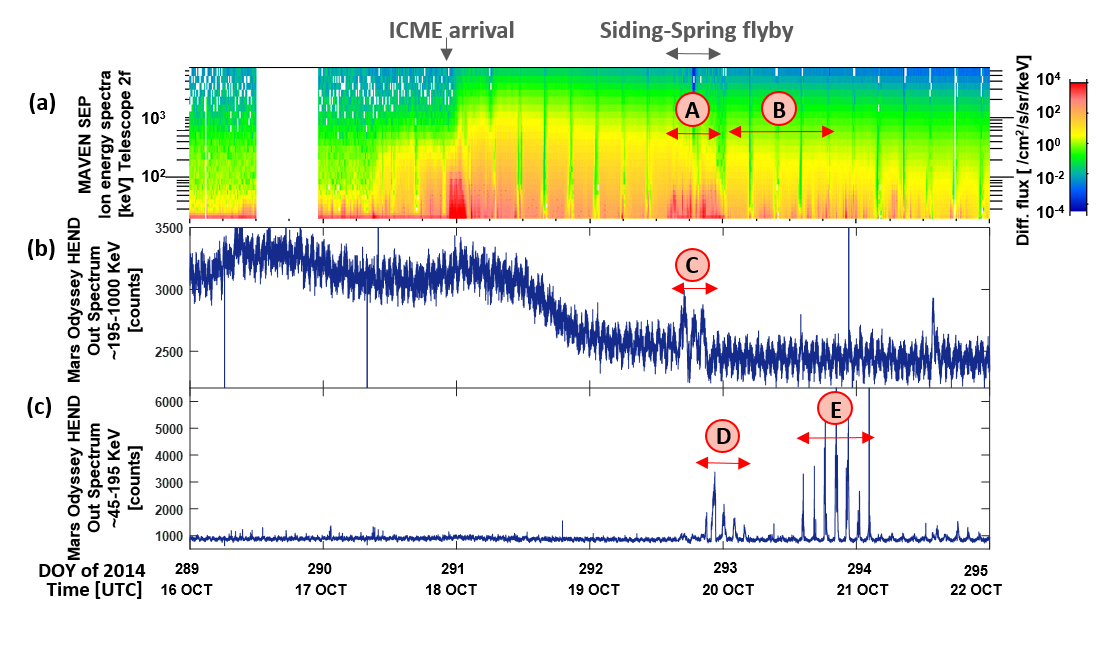MIST
Magnetosphere, Ionosphere and Solar-Terrestrial
Energetic particle showers over Mars from Comet C/2013 A1 Siding-Spring
By Beatriz Sánchez-Cano, Department of Physics and Astronomy, University of Leicester, UK.
On the 19th October 2014, an Oort-cloud comet named Comet C/2013 A1 (Siding Spring) passed Mars at an altitude of 140,000 kilometres (only one third of the Earth-moon distance) during a single flyby through the inner solar system. This rare opportunity, where an event of this kind occurs only once every 100,000 years, prompted space agencies to coordinate multiple spacecraft to witness the largest meteor shower in modern history and allow us to observe the interaction of a comet’s coma with a planetary atmosphere. However, the event was somehow masked by the impact of a powerful Coronal Mass Ejection from the Sun that arrived at Mars 44 hours before the comet, creating very large disturbances in the Martian upper atmosphere and complicating the analysis of data.
Sánchez-Cano et al. [2018] present energetic particle datasets from the Mars Atmosphere and Volatile EvolutioN (MAVEN) and the Mars Odyssey missions to demonstrate how the Martian atmosphere reacted to such an unusual external event. Comets are believed to have strongly affected the evolution of planets in the past and this was a near unique opportunity to assess whether cometary energetic particles, in particular O+, constitute a notable energy input into Mars’ atmosphere. The study found several O+ detections while Mars was within the comet’s environment (at less than a million kilometers distance, see period A in the figure below). In addition, the study discusses several other very interesting showers of energetic particles that occurred after the comet’s closest approach, which are also indicated in the figure below. These detections seem to be related to comet dust tail impacts, which were previously unnoticed. This unexpected detections strongly resemble the tail observations that EPONA/Giotto made of comet 26P/Grigg-Skjellerup in 1992. In conclusion, the authors found that the comet produced a large shower of energetic particles into the Martian atmosphere, depositing a similar level of energy to that of a large space weather storm. This suggests that comets had a significant role on the evolution of the terrestrial planet’s atmospheres in the past.
For more detailed information, please go to the paper:
Sánchez – Cano, B., Witasse, O., Lester, M., Rahmati, A., Ambrosi, R., Lillis, R., et al (2018). Energetic Particle Showers over Mars from Comet C/2013 A1 Siding‐Spring. Journal of Geophysical Research: Space Physics, 123.https://doi.org/10.1029/2018JA025454

Figure: MAVEN and Mars Odyssey observations as a function of time of a powerful Coronal Mass Ejection on 17th October 2014, and of comet Siding-Spring flyby on 19th October 2014. It can be seen that from the point of view of energetic particles, the comet deposited a similar amount of energy than a solar storm on Mars’ atmosphere. (a) MAVEN-SEP ion energy spectra (b) Mars Odyssey-HEND energy profile from higher-energy channels. (c) Same as in (b) but for lower-energy channels. Periods A and B indicate the comet O+ detections at Mars. Period C shows similar detections although the particle identity cannot be determined. Finally, periods D and E shows dust tail impacts on the instrument.